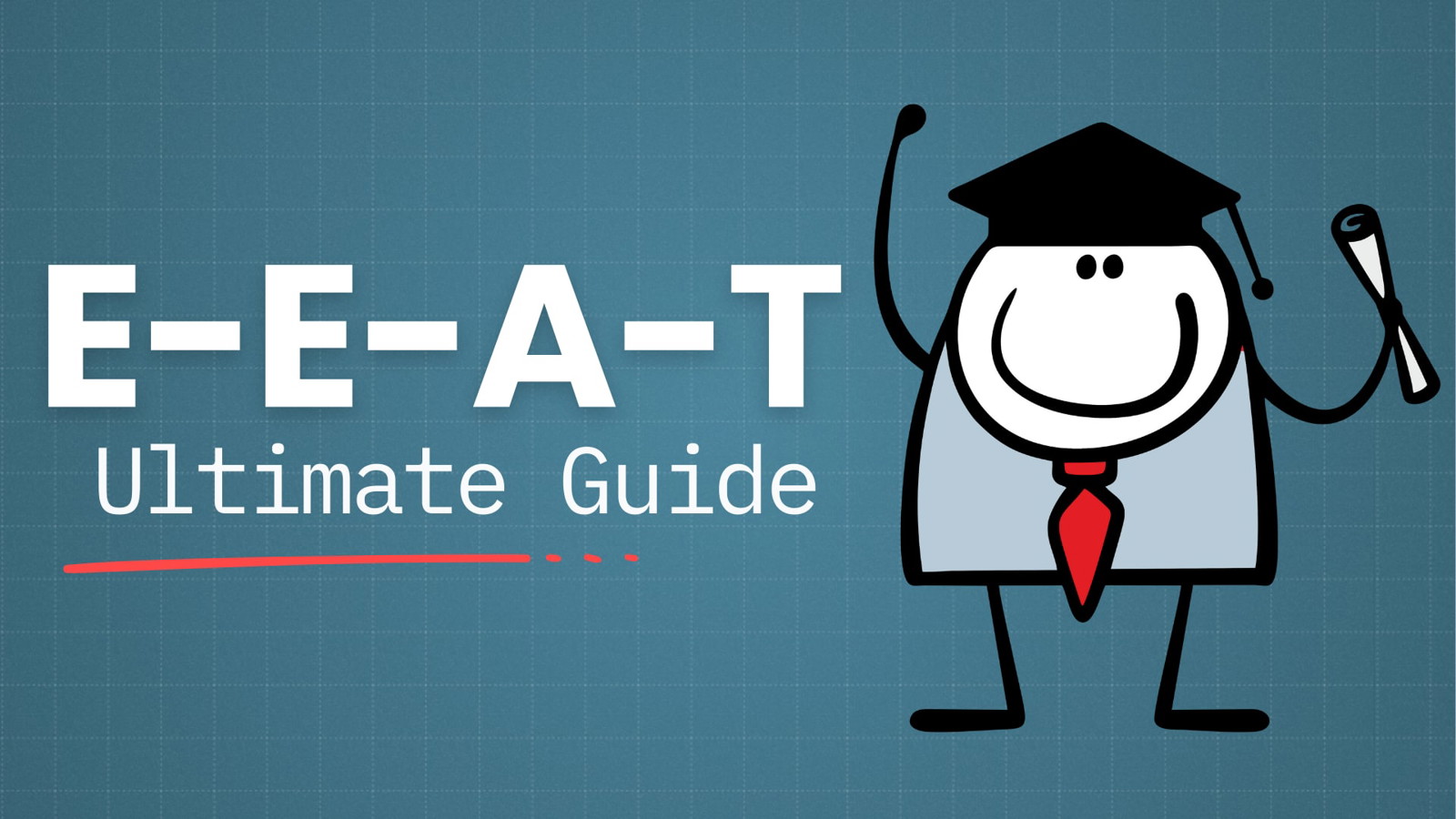Surfer SEO is one of the best data-driven tools to help you find keyword ideas and improve your content ranking.
The impact it has on your content rankings is undeniable. And it’s the reason we’re using Surfer SEO to optimize ALL of our articles.
But what makes it so great?
How can you know it’ll work for your site as well?
Aren’t there cheaper or better alternatives?
If you want the answer to those questions, and more, read our Surfer SEO review below.
What Is Surfer SEO
Surfer SEO is a cloud-based on-page optimization tool that allows you to analyze and compare your pages against those that currently rank on the SERPs.
Instead of guessing what Google likes to rank, this tool offers a data-driven analysis of exactly what’s missing from your page, site, content plan, and more.
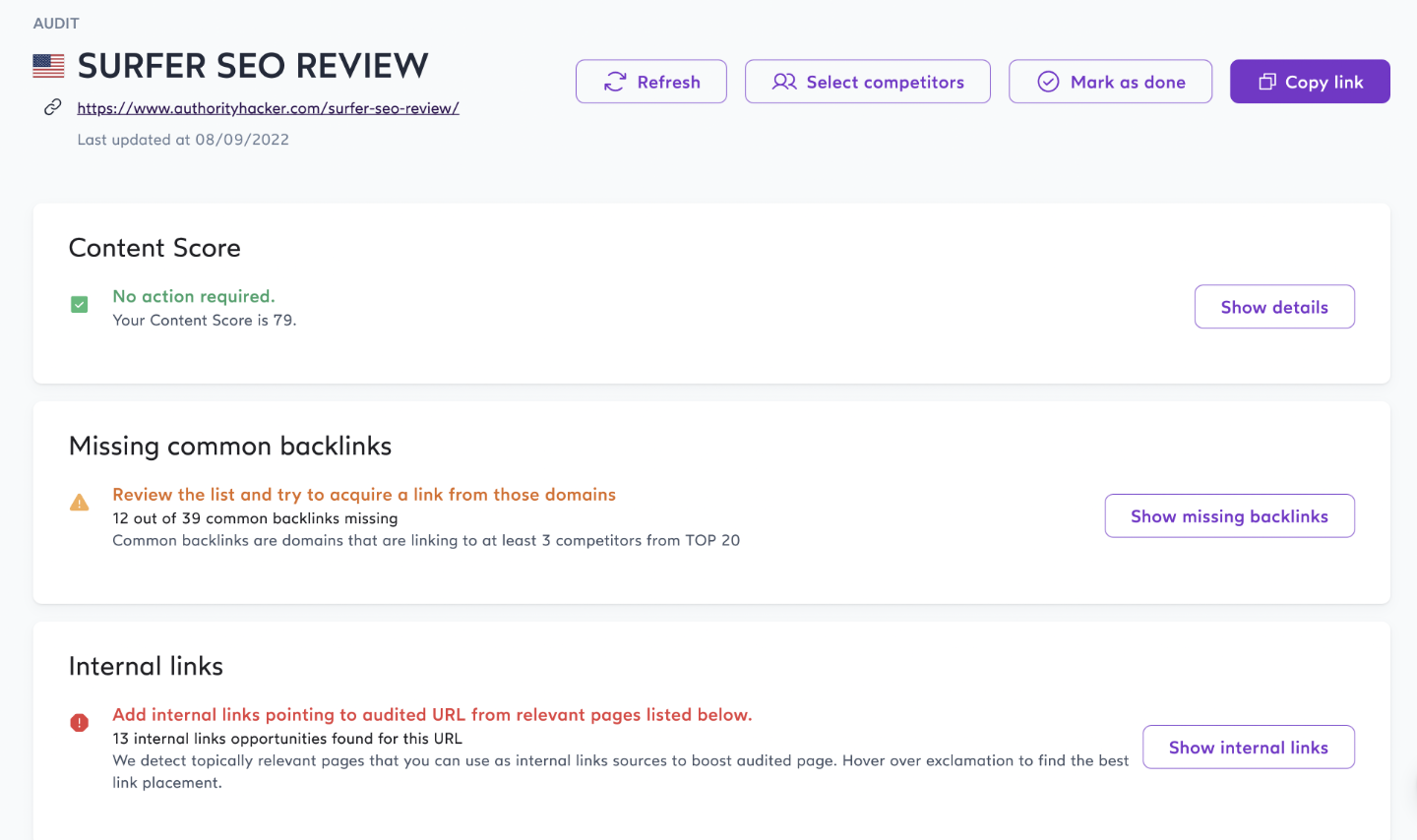
How Can The Surfer SEO Tool Know All Of That?
For all queries, SERPS, and pages that you want to analyze, Surfer SEO studies the top page rankings.

Surfer SEO will look at these results and identify on-page SEO metrics like:
Main and sub-keyword usage
LSI/NLP/TF-IDF keywords
Meta tags (meta description, schema, etc.)
Media elements
Incoming backlinks
Word count
Outgoing external and internal links
Headline Structure
With these metrics, Surfer SEO can build a pretty useful model of what search engines want to see on a specific query.
But it goes even deeper than content optimization. Surfer SEO has plenty of tools to help you research keywords, analyze SERPs, optimize your site overall, and plenty more.
Check out our video review for an in-depth dive:
There are some SEO tools that share similar features with Surfer.. Ahrefs (review) can do keyword research, and Frase IO (review) has decent on-page options.
Why shouldn’t you pick those?
If you want to know more about how Surfer SEO works and if it’s right for you, read our full review below for the complete picture.
Surfer SEO Features
Surfer SEO’s crowning jewel is its content editor, which can work wonders for your on-page optimization.
It can honestly take your page from struggling on the 15th-17th spot of a SERP to ranking in the top three just by editing your content and not building any backlinks.
So that’s what we’ll focus on the most, to see why it’s so successful.
But don’t worry, we’ll show you everything else Surfer can do.
Content Editor: Surfer’s Biggest Hit
Surfer SEO’s content editor is pretty straightforward.
You pick a keyword that you want to target (or several):

You then wait a bit for Surfer to scrape the top results and analyze them, and then you can start creating your new article.
This is what the main Content Editor’s interface:

You get a limited rich text editor and in-depth suggestions on the right.
There, you get a content score that assesses how Google-friendly your content is compared to the other entries on the SERP. You also get recommendations for formatting, like how many words you should write and how many images you should use, etc.
Don’t be like many beginners, and treat these as hard rules. They are merely guidelines and don’t represent 100% of what Google deems important, but they’re extremely useful for steering you in the right direction.
For example, the word count can sometimes be hard to pin down since Surfer’s scraper sometimes takes comments, sidebar, and other elements into account when deciding how long a piece of content is.
So don’t take everything it gives you at face value.
Below that, you’ll find Surfer’s unique keyword recommendations, which tell you what keywords to use in your article and how many times they should appear.
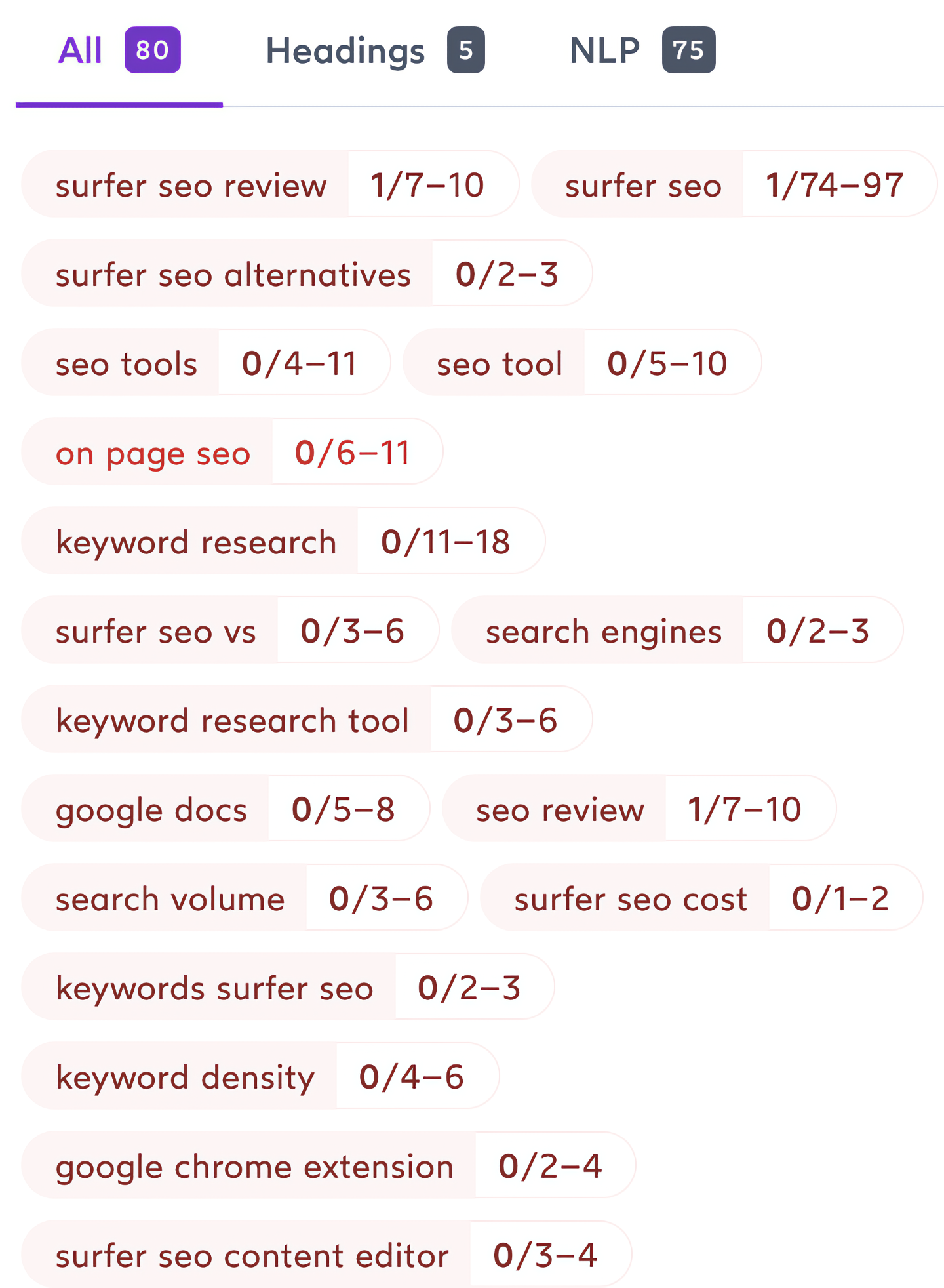
Once you use the right keyword enough times, they will turn yellow and then green to let you know you’ve used them enough in the document.
If you click on a keyword, you’ll even get recommendations for how to use it in-text:
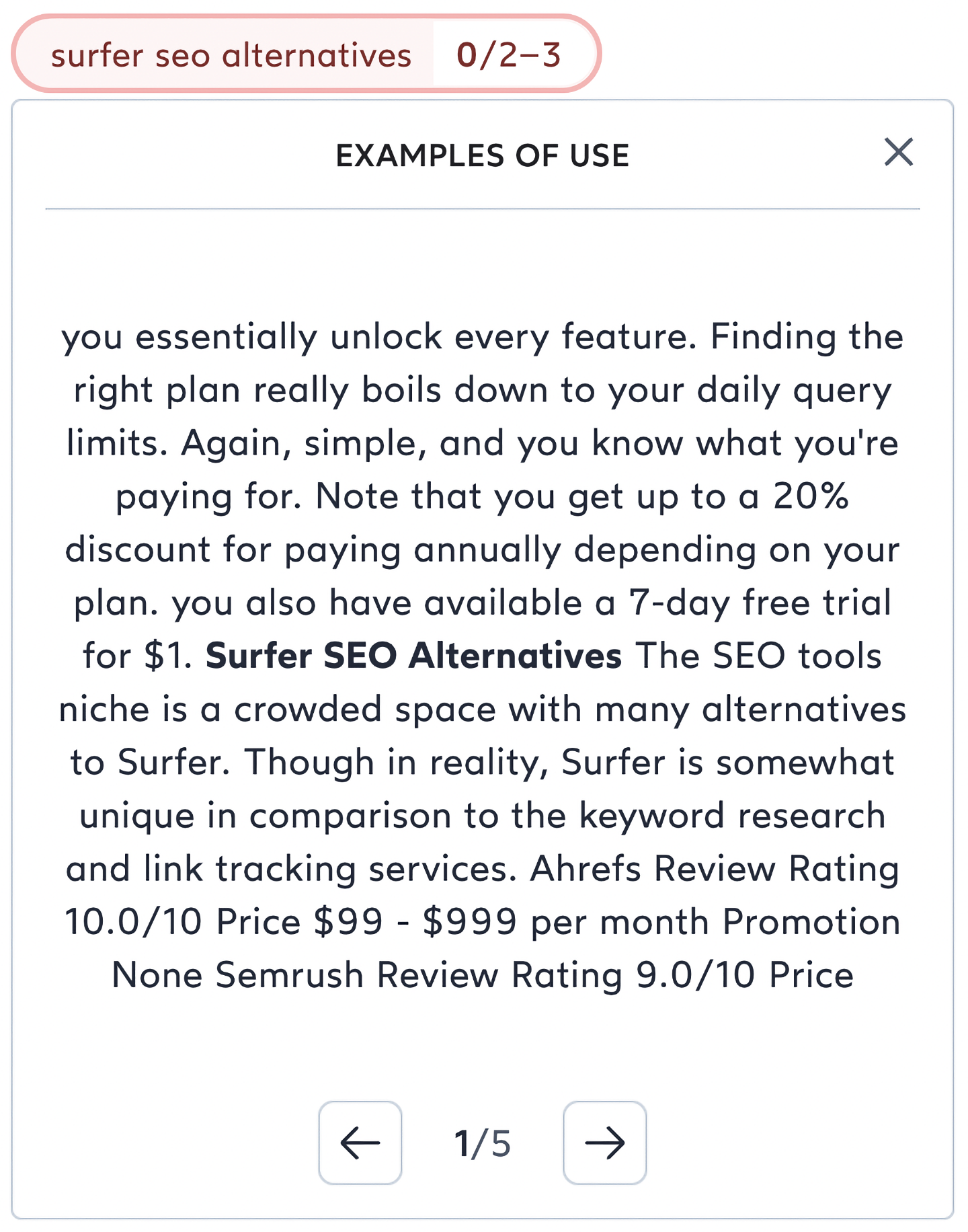
Sometimes these recommendations are grammatically incorrect and can’t really be used in the content without sounding bad. But for a fair Surfer SEO review, I’ll say that I’ve started seeing these bad suggestions less and less in Surfer.
It’s getting better as time goes on.
Besides these options, you also get an Outline and a Brief tab.

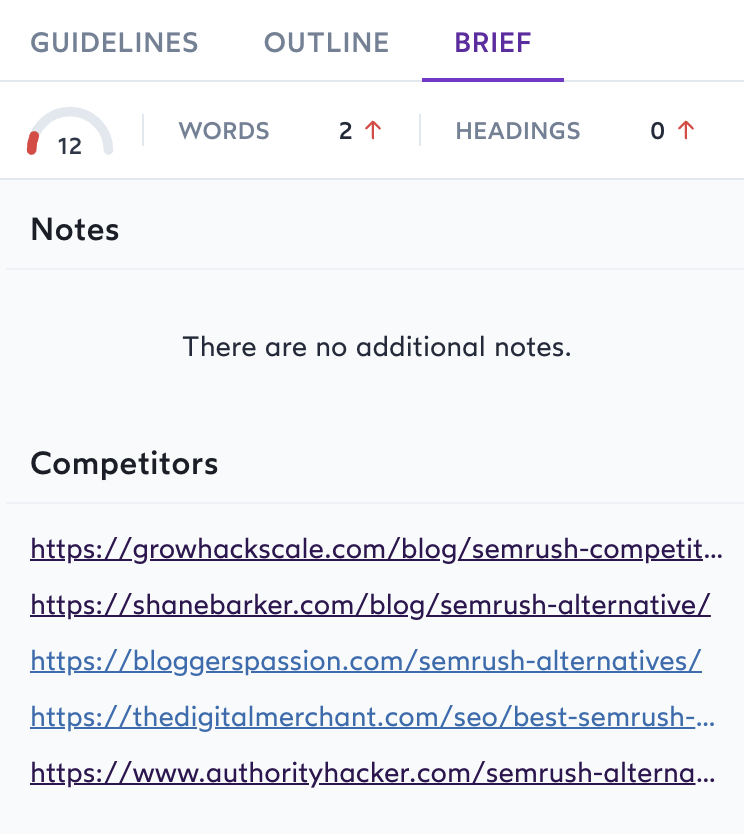
The Outline Builder is a very basic AI writing software that creates sections of content based on your competitor’s content.
The problem is that it’s not always truly unique content and can easily be caught by plagiarism checkers, so I wouldn’t recommend using it on sites you care about.
Another problem of the outline section in practice is that these options sometimes get thrown off by FAQ sections and sidebar info. The result: pretty messy suggestions:
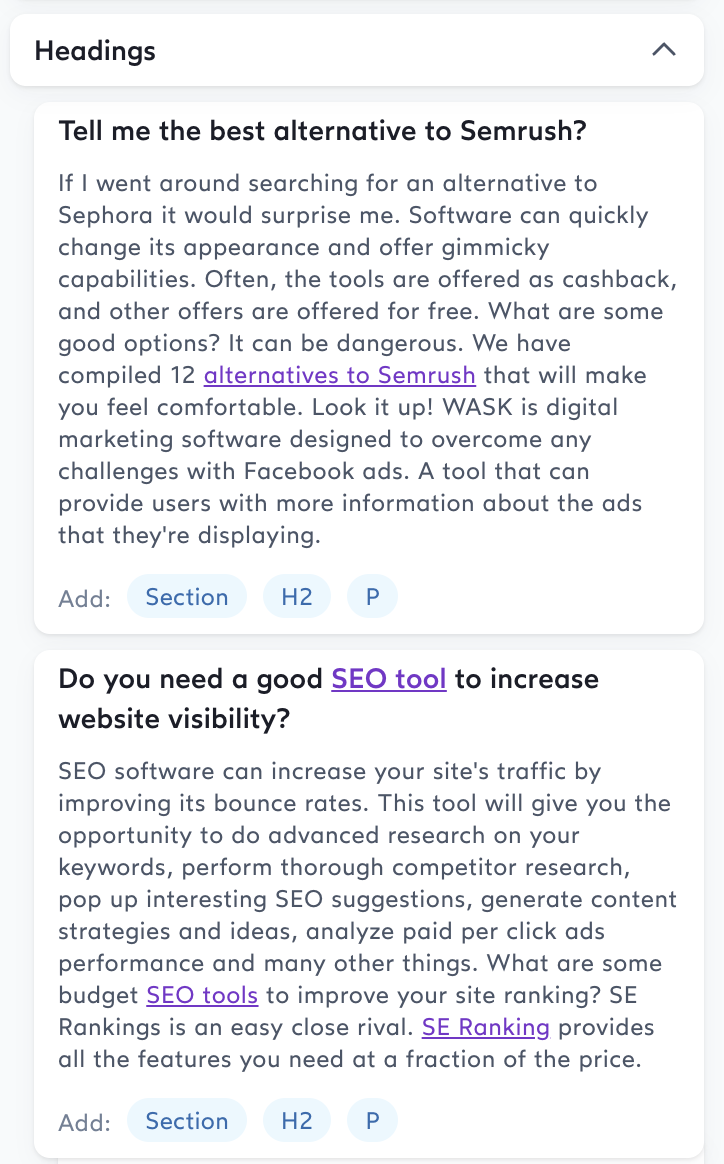
It’s still useful to take a glance at it for inspiration, but I don’t find this particularly well-executed or useful in a quality editorial process.
The outline tab, in particular, is very useful. In theory.
The brief tab summarizes the competitors you’ve selected and the notes you’ve added for the piece, which can be useful if you collaborate with multiple people on the same content.
One important thing to note is that you can edit the results Surfer takes into account when making suggestions:
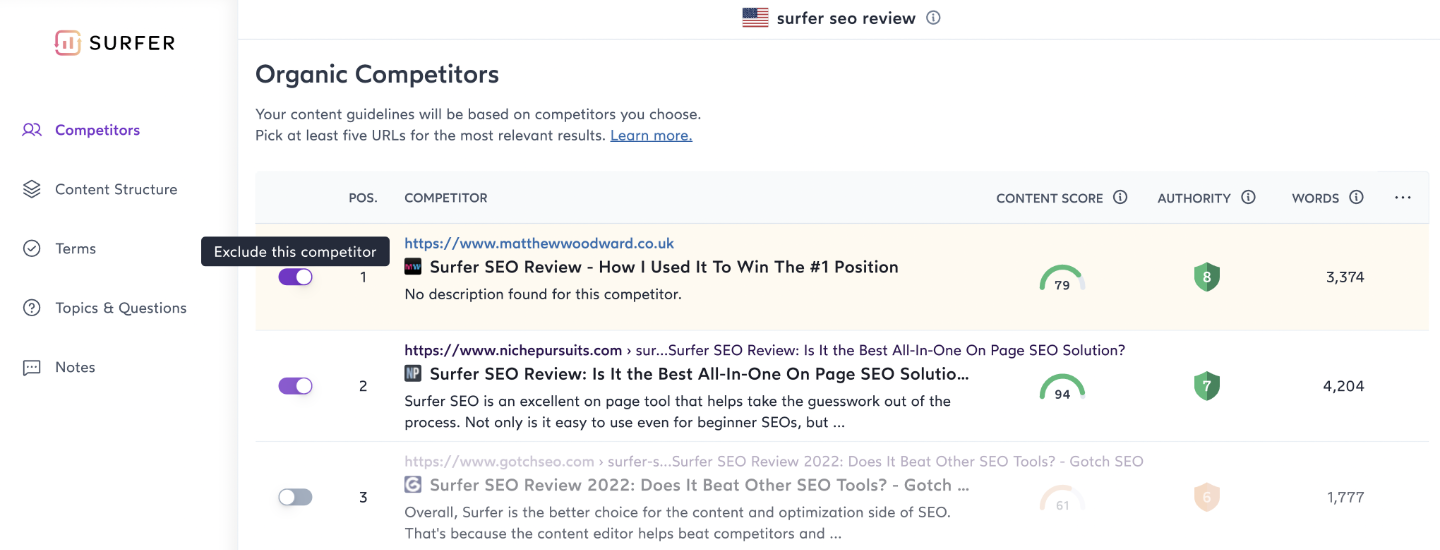
Besides competitors, you can also edit what content structure, terms, topics, and questions you want Surfer to consider.
So, for example, if you disagree with the suggested word count, you can easily edit it, and it will change the number of occurrences of all long tail keywords suggested, thus avoiding over-optimization.
It’s important to check the competitors list whenever you create a new document, as some SERP results might be irrelevant to your purpose.
For example, if you’re writing an in-depth review like this one, you won’t care about SERP entries from sites like G2 or Capterra.
The Content Editor is also available directly in Google Docs:

And even WordPress’ Gutenberg editor:
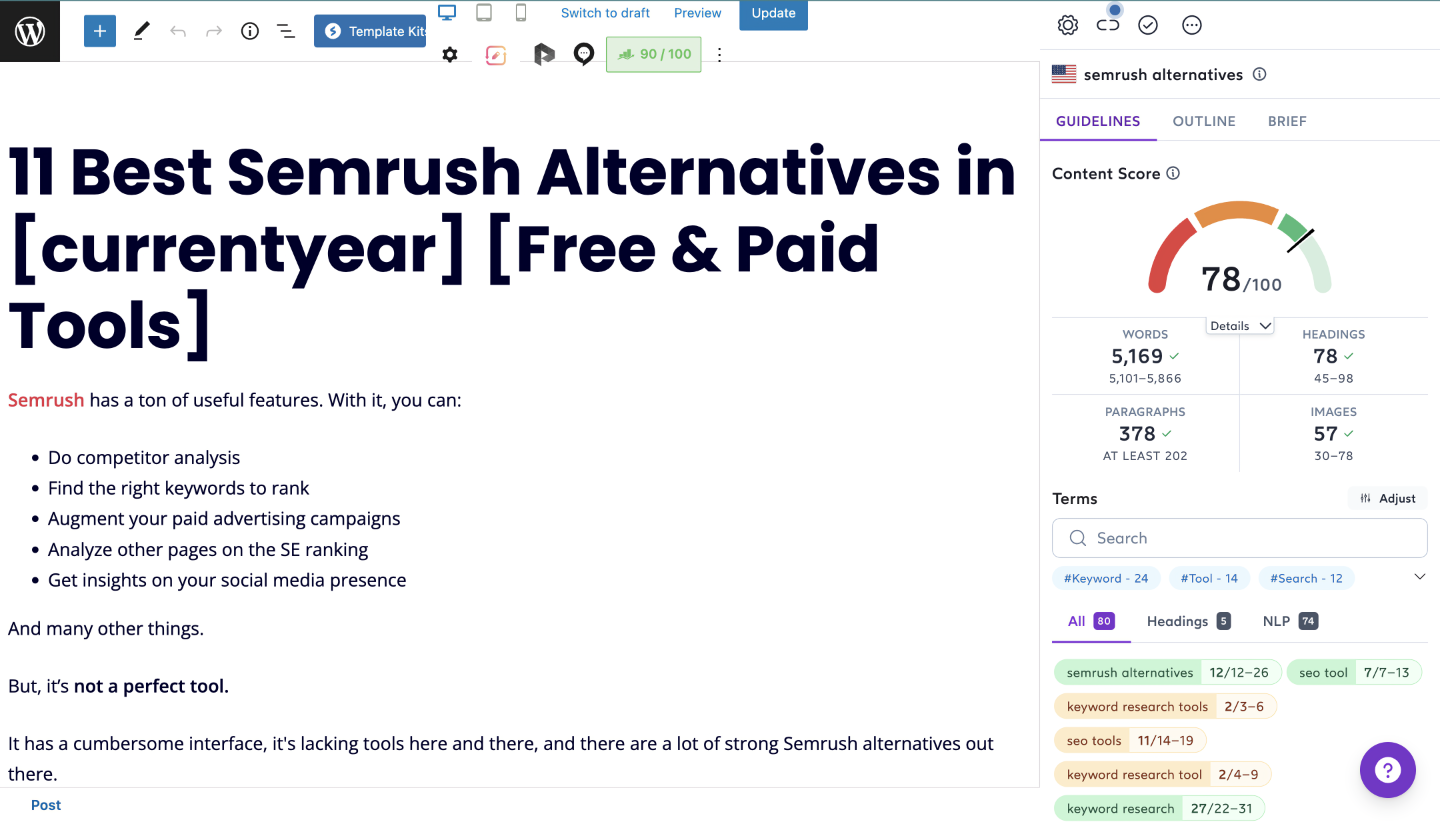
This is really great as most editorial processes run in one of these 2, and you don’t have to choose between optimizing your content or your favorite text editor.
Not to mention, Surfer has added plenty more integrations with tools like Jasper AI. This makes Surfer extremely easy to use, regardless of your editorial processes.
However, I want to point out that the Jasper integration is a missed opportunity.

The tool, in its current form, is somewhat useful. You can optimize content after it’s been generated, sure.
But it’d be 100 times more useful if Jasper AI considered keyword recommendations when creating AI content.
SERP Analyzer
Surfer SEO’s SERP Analysis app is a great way to dive deep into the competition for a particular keyword from a content-first point of view.
Here’s what I mean: The main report you get is a graph of word count in relation to average position over time:

The initial view is a little odd as I doubt many people care about the word count of page 4 ranking pages, but you can easily adapt the scale.
You can edit the metrics shown by the graph on the left sidebar:
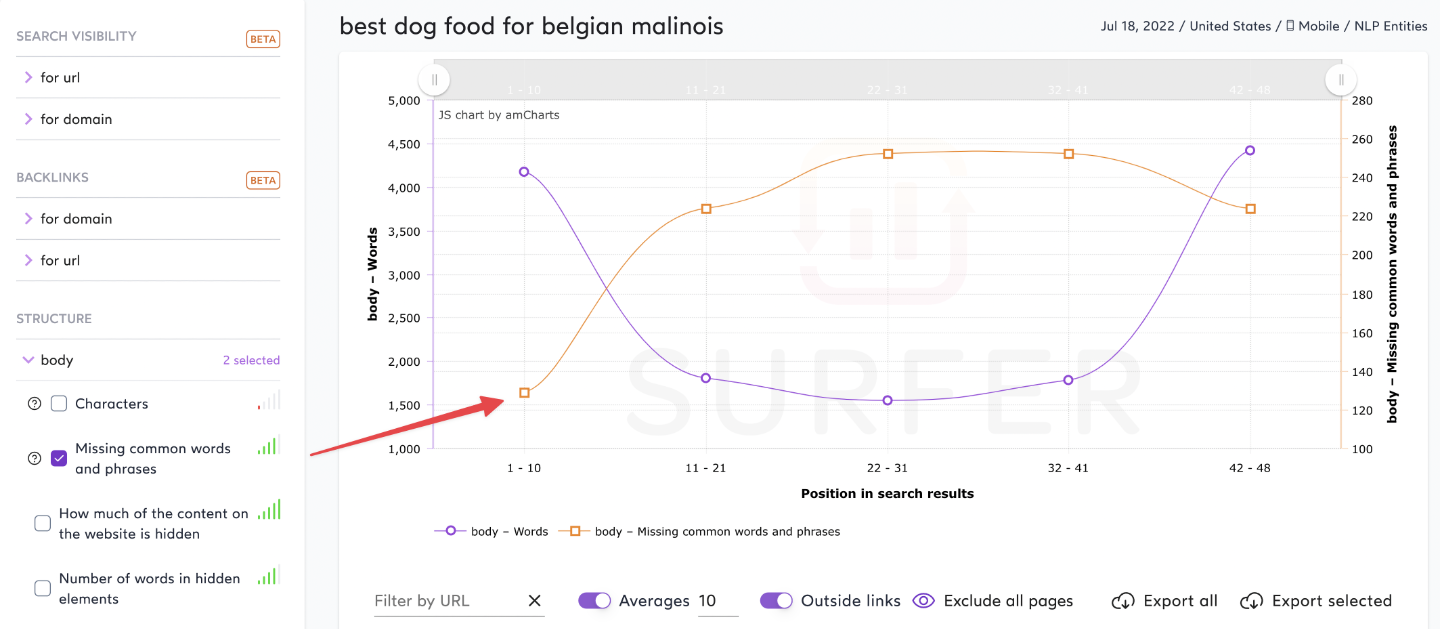
This tool has over 500 factors, like characters, titles, scores, multimedia, and even page speed metrics.
Here’s something cool you can do with this report: by default, it’s comparing you with all the first 48 SERP entries.
But you can modify it to show results relative to specific competitors:
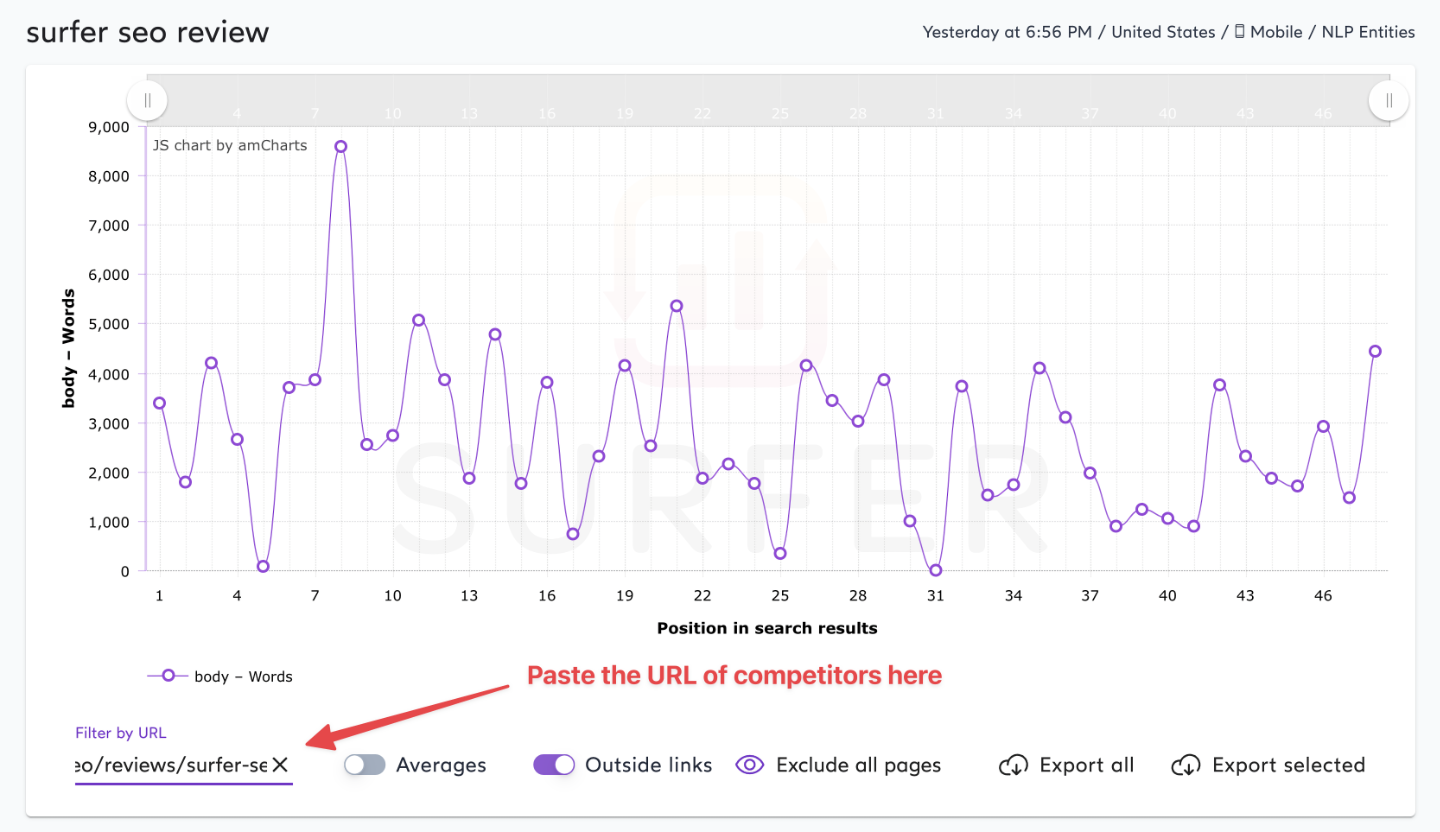
If you want to get more in-depth information, you can also get insights on the popular words to use in your articles, a breakdown of each page and its content score, as well as a new feature that shows you common backlinks for the SERP you’re looking at:

Surfer’s SERP breakdown is complex. It offers tons of useful information and advanced customization options to create your own reports.
It’s probably even more complex than you think. Surfer takes over 500 factors into account when analyzing search engine results pages.
Content Audit
Do you want to update old content that’s no longer ranking or that you feel has the potential to conquer a SERP?
Surfer SEO can help with this as well.
Their content audit feature analyzes your URL and the SERP of its main keyword and gives you a lot of suggestions for improvement based on that:
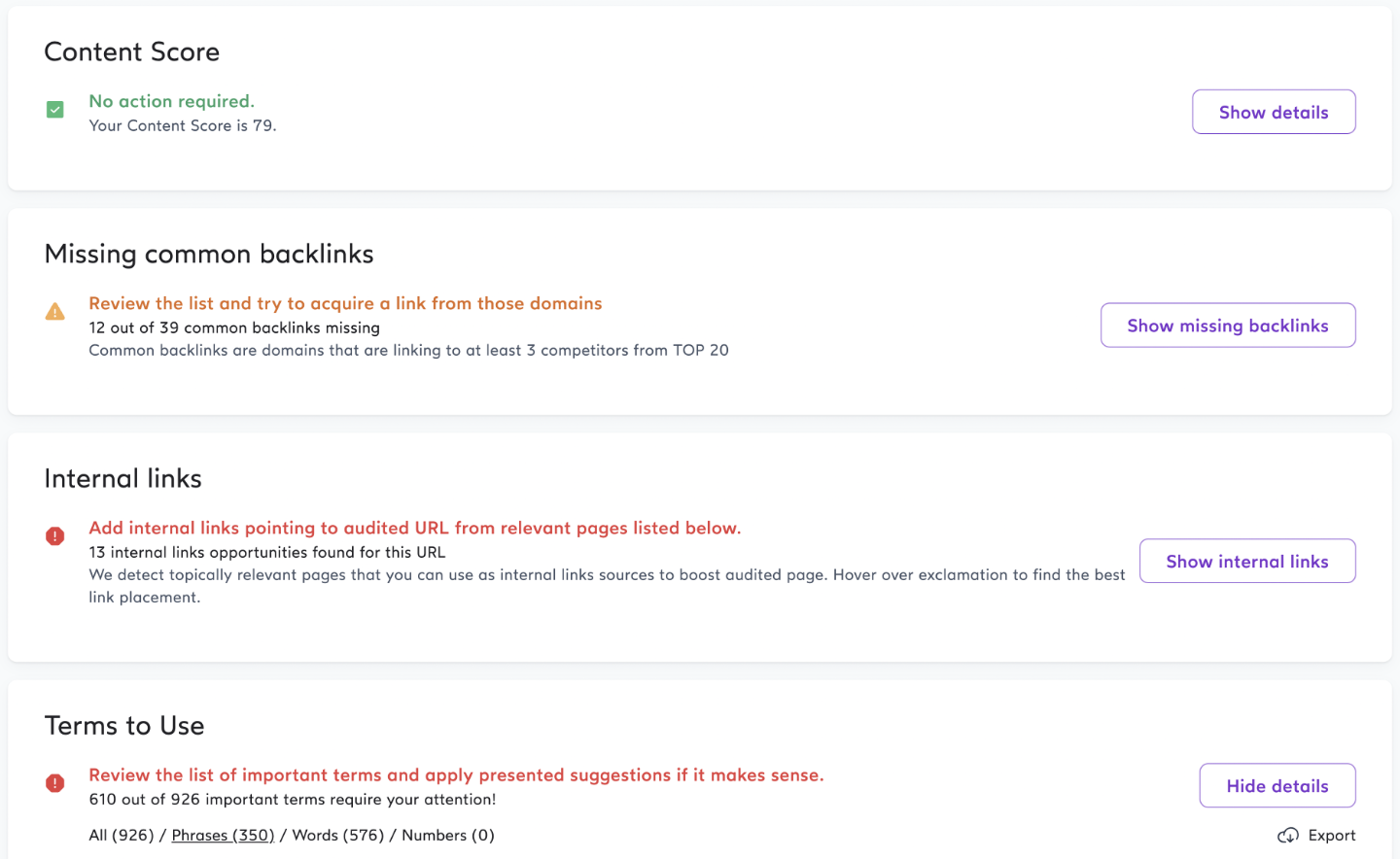
Like with the content editor, you can also filter competitors to get accurate results no matter what. But honestly, Surfer SEO is getting pretty good at filtering useless entries on its own.
This tool has been particularly useful to us on many occasions. Running your older content through it can really improve your rankings, so we highly recommend you try it out!
Content Planner
If you’re unsure where to start planning content for your site, Surfer SEO can also help.
You just have to give it a broad keyword you know you want to focus on:

And it will give you back clusters of related content:

Each cluster is supposed to be an entire article, and it’s all pretty convenient.
You get some preliminary data for all of them, like monthly search volume and keyword difficulty.
You can even create an individual content editor that considers all the keywords in one cluster.
Surfer does all of this by analyzing multiple layers of data, and it works best when you give it a general seed keyword.
Are these recommendations any good?
Kind of.
They can help kickstart your keyword research process. But I wouldn’t recommend you take these suggestions for granted. They’re not always good opportunities, especially for affiliate sites.
Most of these tools’ limitations relate to Surfer SEO’s keyword research tool.
Keyword Research
For all its pros, Surfer SEO can drop the ball quite easily.
Their keyword research tool is an example of that. It’s not outright bad… but it doesn’t compare with the other Surfer SEO apps.
Or other popular keyword research tools.
The main problem is low volume keywords. They’re the bread and butter of some sites, especially when you’re just starting.
Yet Surfer SEO has very little data on them.
Here’s a relatively decent query analyzed in Surfer SEO:

And here it is in Ahrefs:

Surfer can be helpful for high-traffic keywords, but its keyword research tool is not world-class—at least not yet.
What is slightly more useful is the Surfer Keyword extension:

If you have it installed, it’ll display some search metrics for anything you Google:
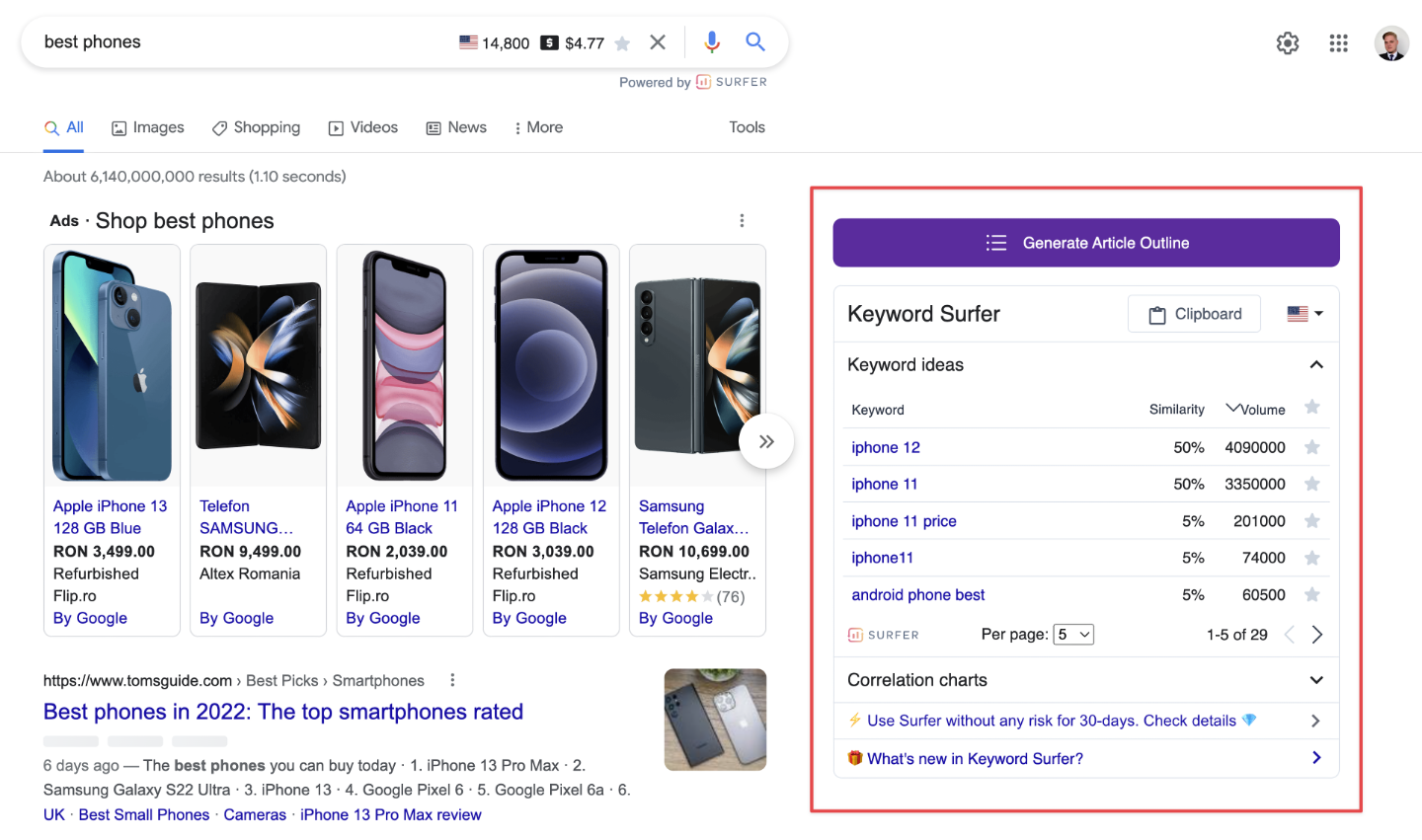
I like that you can use this to research “on the go.” You don’t have to open complex tools just to see if you can try your hand at a new organic topic.
But there are alternatives out there. And they generally have better data.
Surfer SEO Review: The New Grow Flow
Surfer SEO’s newest feature, the Grow Flow, is an AI-driven assistant that’s supposed to help you improve your SEO presence with simple, actionable tasks.
As far as we can tell, it’s pretty good.
These are the suggestions we got when setting up the tool:

Surfer basically uses the research capabilities it developed after years of content editing, applies it to your entire site, and identifies areas of improvement.
Here’s a funny story. Before we tried Grow Flow, we analyzed our site and did in-depth keyword research to determine what we could improve.
We used tools that cost hundreds of dollars a month.
And our decades of experience.
In minutes, Surfer SEO could also identify some of the tasks we outlined after our own analysis.
But hold your horses for a minute.
The Grow Flow is imperfect and can’t replace good tools and expertise.
For example, we also got content recommendations that don’t really make sense:
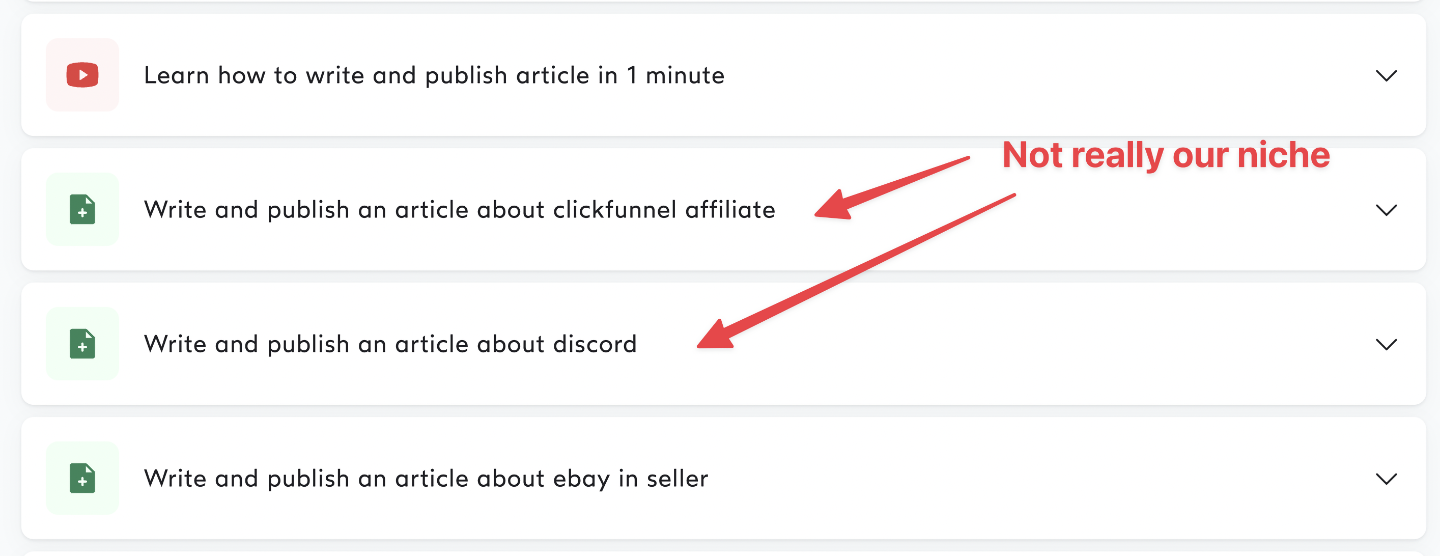
And even suggestions to get links back to sites are not ideal.
So if you don’t have the tools and expertise to find growth opportunities on your own, the new Grow Flow can help.
But it’s far from enough.
Why (And How Well) Surfer SEO Works
Surfer SEO uses “Correlational on-page SEO” to offer most of its suggestions.
This basically means correlating success on the SERP with on-page elements like content length, keyword distribution, and more.
Does this work? Let’s find out.
The Rise of Correlational On-page SEO

Historically, SEOs have followed “one size fits all” On-page SEO rules.
For the most part, it has worked fine for years while Google was still displaying 10 blue links on each search query.
But as time passed, Google started to branch out of its one-size-fits-all algorithm and now tends to prefer different types of content depending on the query.

Additionally, with the rise in user metrics collection, they have been able to tell which content does better for each query.
As a result, depending on the query, the rules change.
And this is where correlational SEO comes into play.
Correlational SEO involves scraping the top results for a given query and analyzing what all the top pages have in common from a statistical point of view so you can emulate it on your pages and serve Google exactly what they think works best for the query.
Now, does this mean you will rank for the most competitive queries just with Correlational on-page SEO?
Nope.
We don’t want this Surfer SEO review to turn into an advertisement.
On-page SEO tools are great, but according to our own data research, Backlinks are still THE most correlated factor to high rankings.
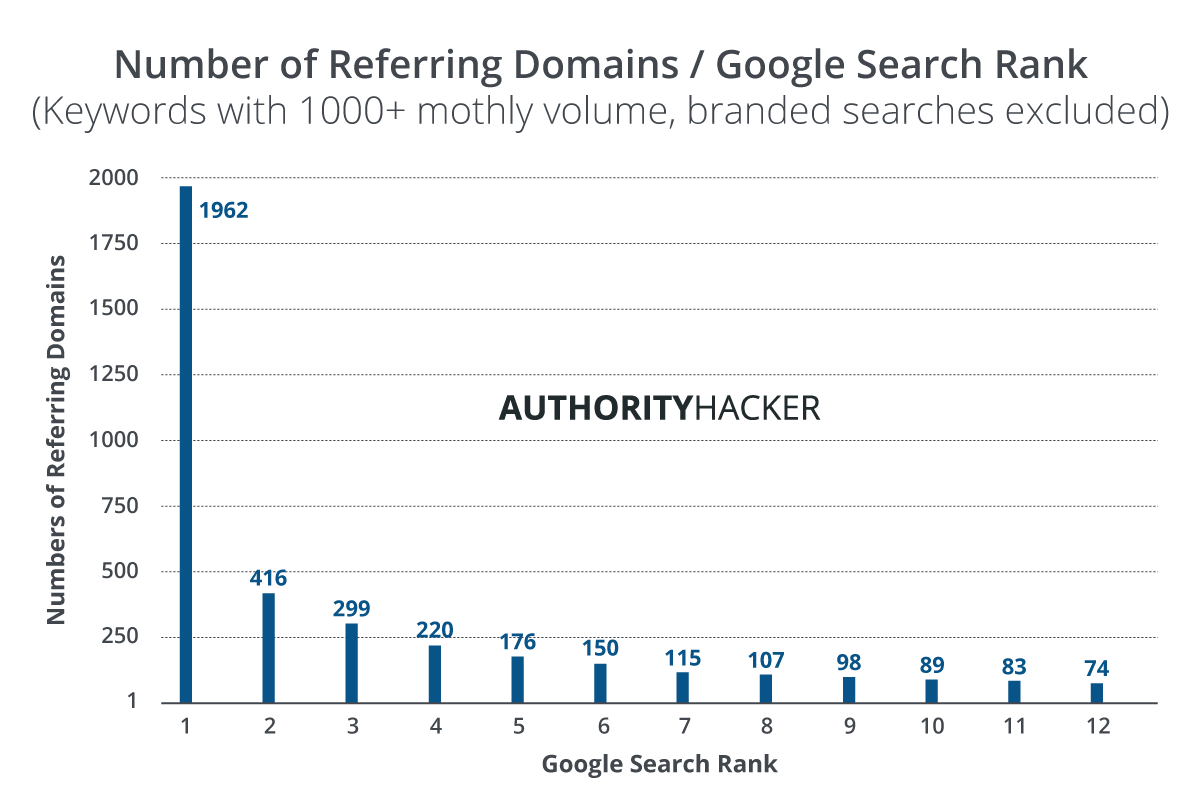
But guess what?
If they rank on top of Google, the top results are likely to have built a decent number of links.
So really, modeling after the top-ranking content also helps your link-building efforts.
Especially if you are using our shotgun skyscraper method.
On top of all of that – new Surfer updates help you kickstart the link-building process by showing you where your competitors are getting their links from.
But copying what’s already working will never be enough. To stand out, get links, and conquer a SERP, you need to offer something extra with your articles.
So really, the trick to do really well in search these days is to be able to create content that structurally resembles what is ranking already while also doing things like:
- Creating new original insights through case studies or data collection
- Improving production value (media, engaging copy, etc.)
- Giving more practical, real-life advice
The really cool part is that optimizing your on-page SEO can achieve stellar ranking jumps.
That’s not speculation either – we’ve tested this on Authority Hacker content, and it works.
Double-Digit Traffic Increases
Most SEOs are happy to sit around the virtual water cooler and spin yarns about their latest and greatest theories for boosting page traffic.
At Authority Hacker, we prefer to test theories and show you the results.
Something either works or not – speculation doesn’t cut it for us.
This is an example of our results when upgrading a handful of our pages using only the correlational data provided by Surfer SEO and Website Auditor.

No vanity metrics on display here – just tons more traffic to the pages we optimized with Surfer SEO.
Interface And User Experience
One of Surfer SEO’s biggest perks is its user-friendliness. Creating a new, extremely powerful content editor takes two or three clicks.
And even if you haven’t used too many SEO web apps, the options are really intuitive.
Important settings are also conveniently placed. For example, before you run any search, you can choose the device and language Surfer should focus on:

All dashboards in Surfer SEO are easy to use and well-designed.
Surfer SEO Integrations: Going Beyond Simple On-Page Edits?
Besides integrating with many document editors, Surfer SEO also launched a big partnership with SEMRush.
Here’s what it entails: You connect your SEMRush account to Surfer SEO, automatically enhancing your reports with details on backlinks, especially for the new Grow Flow features.
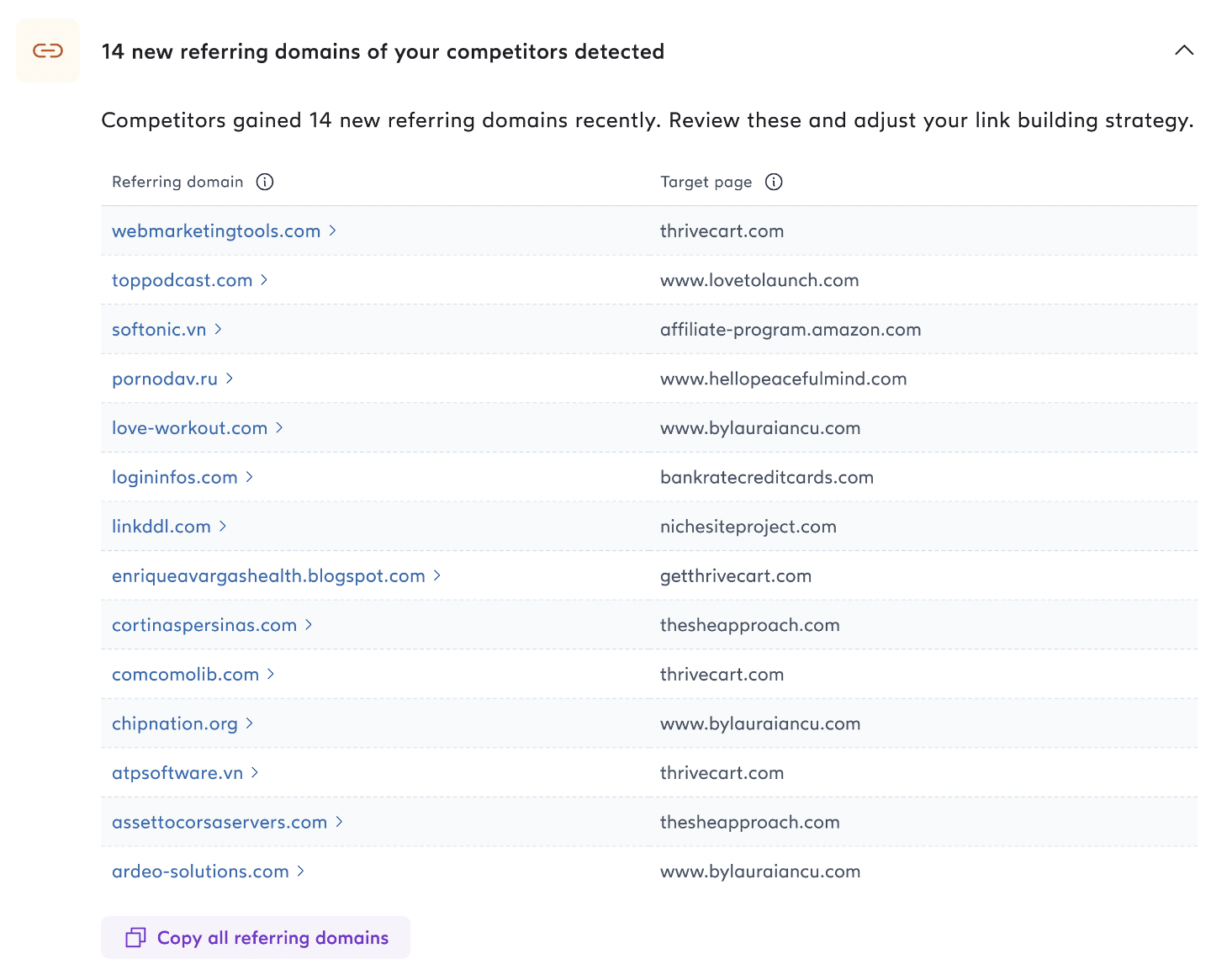
Of course, to enable Grow Flow, you also need to integrate Search Console into Surfer SEO, providing an even deeper analysis level.
But there’s another side to Surfer integrations.
You see, Surfer is really good at hyping up tools. But oftentimes, it’s much more bark than bite.
The Jasper integration is an example. But so is their hyped-up SEMRush integration. Again, really helpful. But nothing too special.
And here’s the thing. Surfer is really good at what it does, but it’s been struggling to find its next big break since revolutionizing on-page edits.
Should they really focus on adding all these new tools?
I think it’d be better if they focused on improving what we already like about Surfer instead of adding crazy integrations or tools like the keyword research app, which nobody really uses.
Tutorial: Optimizing content with Surfer SEO
This quick tutorial assumes you already have a page of content published, focused on a given keyword.
You can then come back to this Surfer SEO review and try out the guide below.
That being said, let’s get into the tutorial.
First, run your page through the Surfer SEO audit tool to optimize your content.

This will give you a lot of helpful insights beyond on-page optimization, like what backlinks you’re missing:

The content audit gives you a lot of helpful tips:
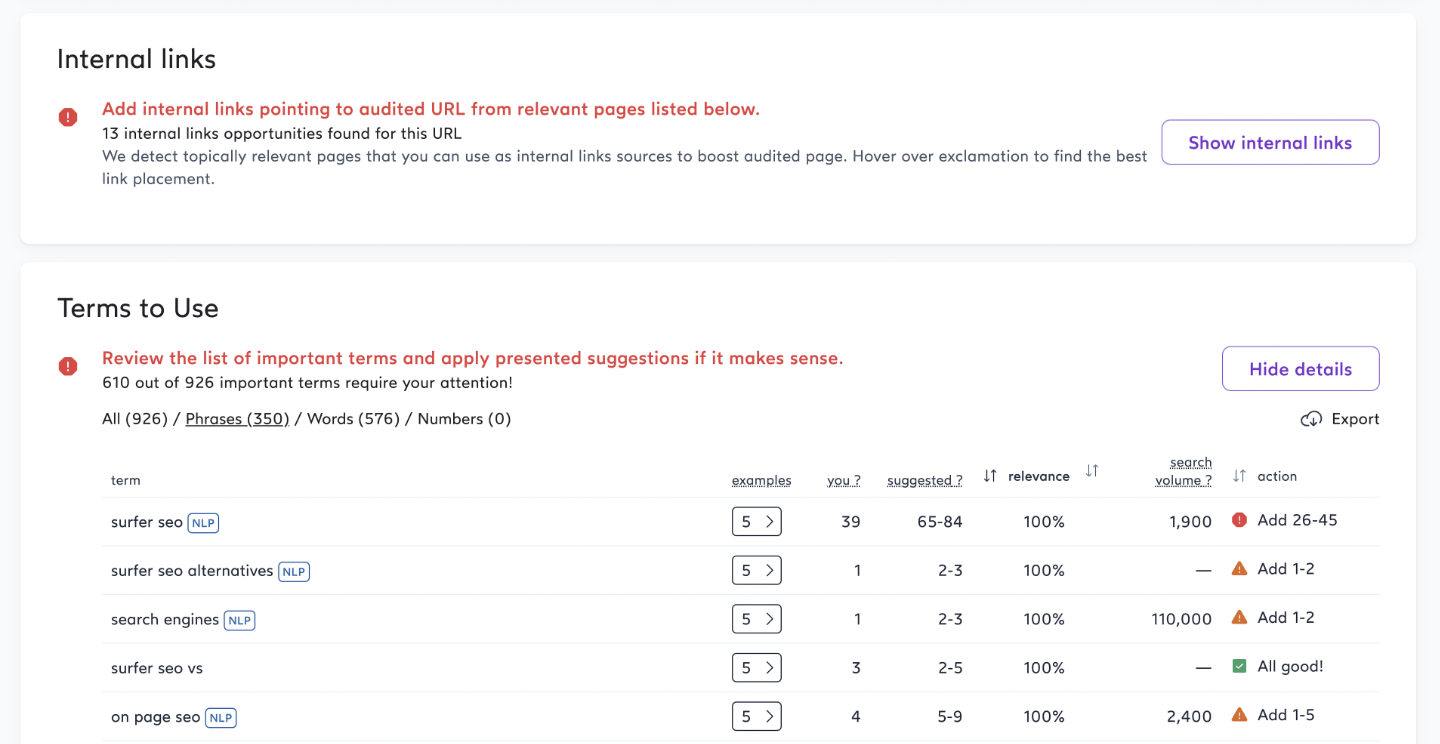
So before anything else, go through these tasks and tick each box. If you’re not sure how to do something, Surfer will provide an explanation, so don’t worry if you’re inexperienced.
In our case, we submitted the URL of this article, and the suggestions were pretty basic: add these keywords, link back to these places, etc.
After you do that, create a new content editor for the keyword you’re after:

In our case, that’s “Surfer SEO review” and “Surfer review”.
Once you click enter, you’ll be taken to a content editor:
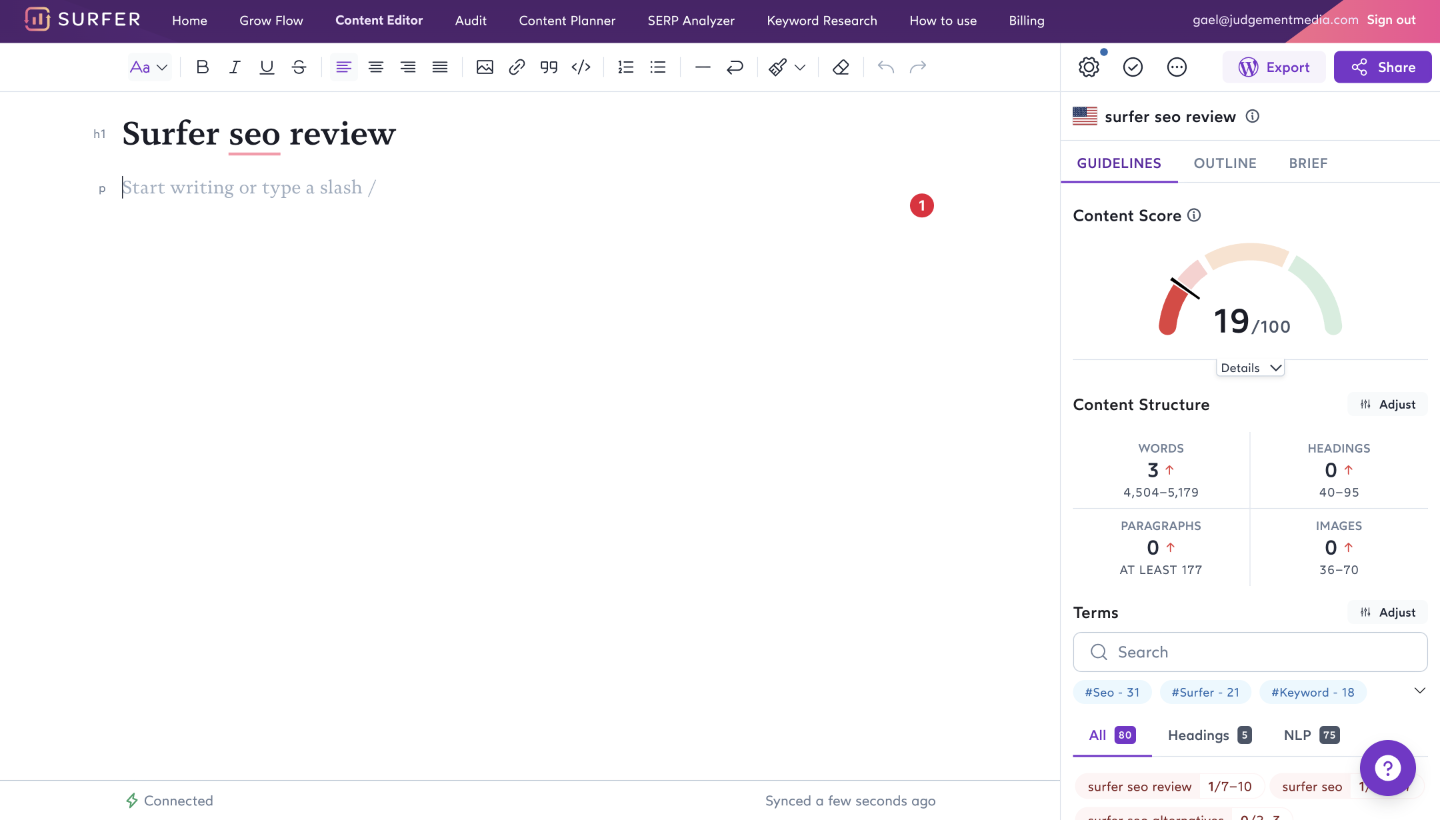
You can paste your content here, optimize it, and then paste it back into Google Docs or WordPress.
But that’s cumbersome, and it can mess up your formatting. So rather, install the Surfer extension:

With this in your browser, you can create a new Google Document targeting your keyword straight from the content editor:

Which will add Surfer’s suggestions directly in Google Docs.
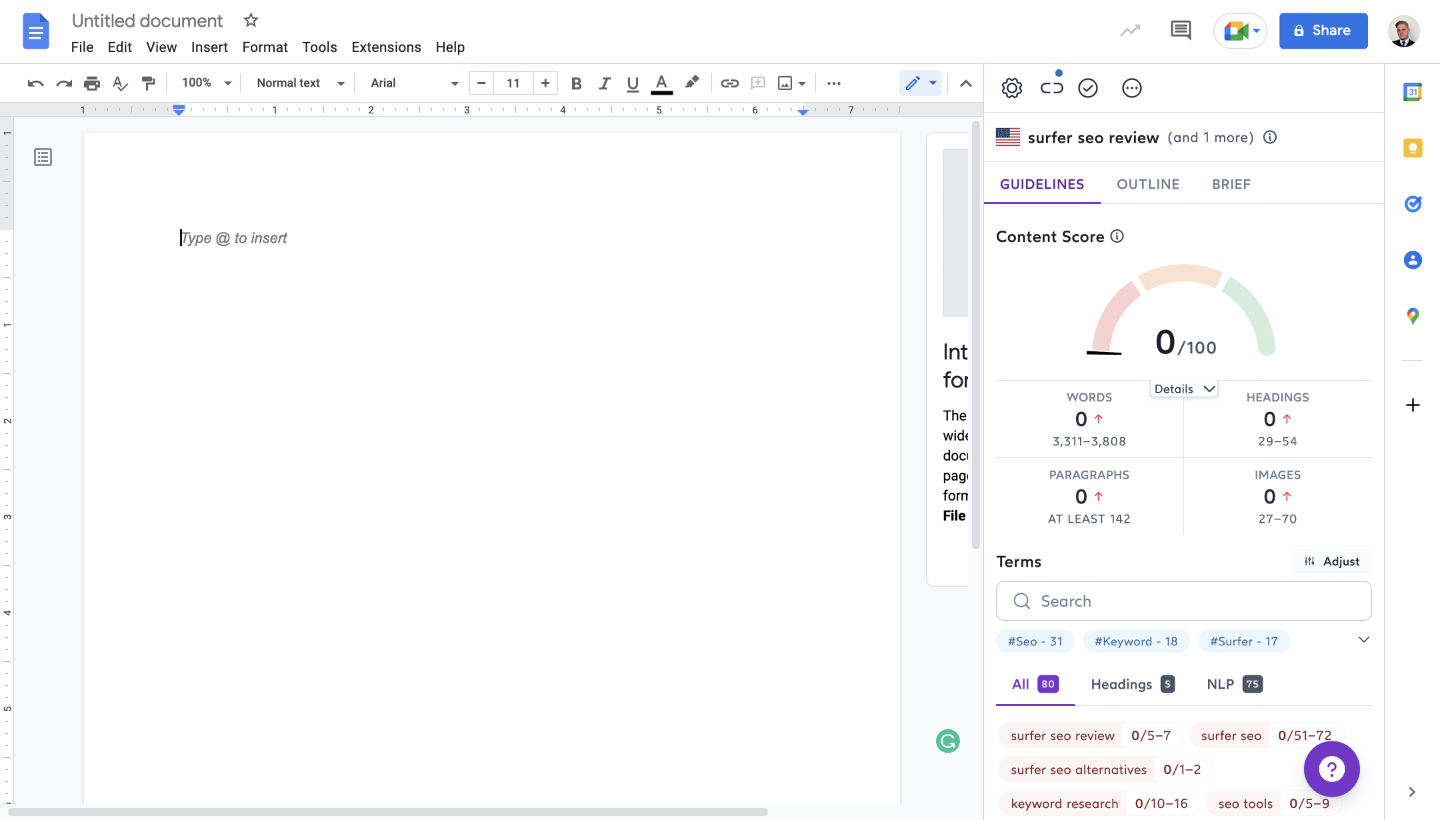
Here’s what your process should look like from here onwards:
Word count is the only truly important aspect of content structure. Aim to be in the ballpark Surfer SEO gives you.
Go through the list of keywords and think of where you can make room for them in the article.
Take each keyword in turn and try to raise its count. Alternatively, you can note 5-6 important keywords to add and sprinkle them throughout the article.
Rinse and repeat until you get a content score above 75.
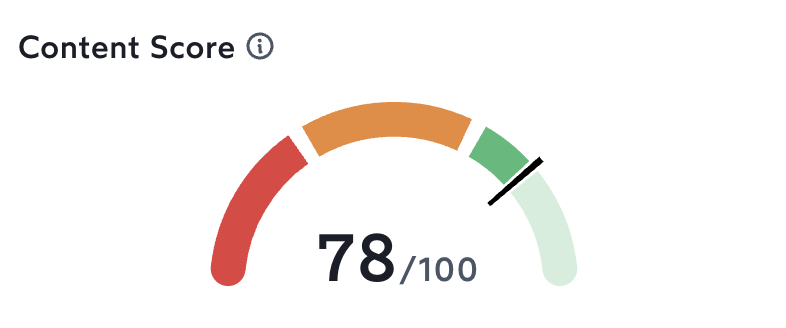
If you want to save even more time, just open the Gutenberg editor and click on the Surfer extension. This will open Surfer’s suggestions straight into WordPress.
However, keep in mind that it can get laggy. If content changes don’t appear immediately on the right, give it a few moments.
What We Like About Surfer SEO
Surfer SEO has a lot of good things going for it.
In our book, these are its best perks:
Ease Of Use – Surfer’s interface is intuitive, and the data it provides is easy to understand and act on.
Content Structure Assistance – Surfer takes over 500 factors into account to decide everything your page needs to rank, including content structure, missing backlinks, and more.
LSI Keywords – Surfer is one of the few on-page tools to help you nail LSI keywords.
Decent Grow Flow – It could be better, and it has some weird recommendations, but it’s a good starting point for beginners.
Good integrations – Often with tools that are important for SEOs.
Constant updates – Although the value of some of their latest tools is disputable.
Where We Wish Surfer SEO Did Better
The first thing people might consider as a Surfer con is its pricing. Surfer SEO is not cheap.
Sure, you can get it for as low as $49. But if you want decent caps to run an affiliate site, you’ll need to pay at least $99 for its Pro plan.

We’re not so sure that’s a con, though. We’re happy to pay extra if it means we’re getting the best service possible.
The other problems we have with Surfer include:
Buggy extension – This is especially true on WordPress, but it’s not a permanent issue; it just crops up occasionally.
Pretty bad keyword research – Nobody gets Surfer for this feature. Probably nobody uses it either.
Plenty of hype, little substance – Surfer is great at what it does: content optimization. We wish it focused more on that.
Surfer SEO Alternatives
Surfer SEO is not the only on-page tool out there. Competition has gotten fierce, especially in recent years.
These are the best Surfer SEO alternatives:
- Cora
- Frase IO
- MarketMuse
- Website Auditor
Surfer SEO vs. Cora
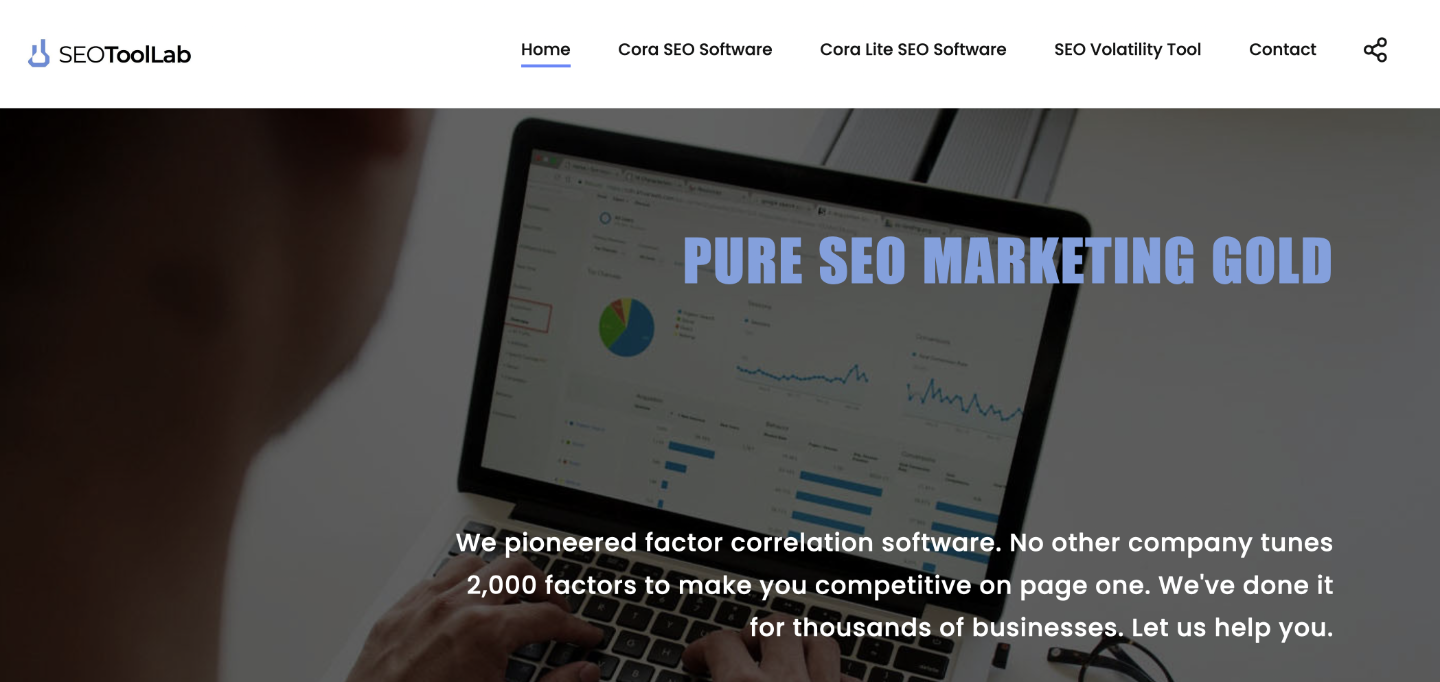
Cora is an on-page analysis tool from the nice folks at SEO Tool Lab. It’s also a force to be reckoned with.
Especially since it has improved a lot in previous years.
When we first wrote this review, Cora was twice as expensive, but it still had some clear pros – good outreach and solid data – made it a nice addition to our list.
Today, it’s even cheaper.
Is it good enough to be a Surfer SEO alternative, though?
Not really. Cora had, and still has a very bad interface.
So, while Cora is often cited as a good alternative to Surfer SEO, it’s not our go-to choice.
Especially because of its price tag. The cheapest you can get Cora at the time of writing is $125/month.
Better than the previous $250 price, but still not too cheap.
If you want a simpler but just as effective tool, Surfer is definitely the better alternative.
Surfer SEO vs Frase IO

Frase IO has expanded into AI writing since its inception. But at its core, Frase is a content optimization tool.
And it’s not half bad!
Frase IO’s SEO on-page keyword suggestions are based on the first 20 results on your keyword’s SERP. And they can often be pretty good.
It also stands out from other AI writing tools by not relying on GPT-3. Content generation in Frase is built on its own language model.
Unfortunately, it does lag behind Surfer SEO in some areas.
Here are the reasons we’re inclined to choose Surfer SEO over Frase IO:
- Much better interface
- Deeper research, taking more results into account
- Personal experience – Surfer SEO and Frase IO recommendations differ sometimes. But we’ve seen nothing but success with Surfer SEO.
- Complex tools to augment SEO efforts in general
Frase IO can be a great alternative to Surfer SEO, but it is also more expensive. Even if you want an AI writer to supplement your on-page optimization needs, you’d still probably be better off with a Jasper AI + Surfer SEO combo.
If you want to find out more, read our Frase IO review.
Surfer SEO vs. Website Auditor

Website Auditor is a little different from the other tools in that it’s not cloud-based – you have to download and install it.
Although it’s part of a suite of software (SEOPowersuite), we’re focusing on the Website Auditor component because it deals with on-page analysis.
So…how does it compare?
Website Auditor (and the SEO Power Suite) is much cheaper than most SEO tools. You can have it for $299/year.
For that money, if you don’t want to worry about caps, you’ll only get Surfer SEO for about three months.
However, while Website Auditor is much cheaper, Surfer’s data and recommendations are much better. So if you want the best solution for on-page optimization, you should still get Surfer.
But if you like desktop apps and want a comprehensive SEO tool, you can look into the SEO Power Suite more. It’s actually featured on our list of the best SEO tools for Mac.
Surfer SEO Review Conclusion
Surfer SEO is not perfect. Its keyword research is pretty bad, and we’re not big fans of all of their newest app releases.
Not to mention, its pricing point can be a barrier to entry for many people.
Nonetheless, Surfer SEO is probably a must-have for anyone trying to rank organically.
Its data and content editor are just that good.
FAQs
Surfer is worth it if you are looking for a tool to help you with on-page optimization based on correlational SEO. Surfer can give you actionable suggestions on improving your content, structure, keywords, backlinks, and more.
SurferSEO and SEMrush are different types of tools that serve different purposes. SurferSEO mainly focuses on on-page optimization, while SEMrush is a comprehensive SEO platform that covers keyword research, competitor analysis, site audit, rank tracking, and more.
Surfer analyzes the top-ranking pages for a given query and finds the common factors that correlate with their ranking. It then uses these factors to generate suggestions on how to optimize your own page for that query.
NLP stands for natural language processing, a branch of artificial intelligence that deals with the interaction between computers and human languages.
NLP in SEO refers to using NLP techniques to understand the intent and context of search queries and web pages and to create or optimize content that matches the user’s needs and expectations.
Surfer SEO Review 2024

Surfer SEO offers to find exactly what you need to change to your page to rank higher for your target keywords. Simply input your query and follow the guidelines.
Price: 49
Price Currency: $
Application Category: SEO Software
4.5



